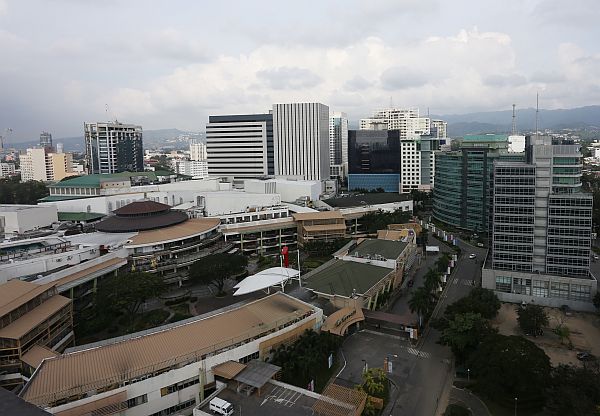How safe are Cebu’s buildings if an earthquake strikes

Cebu Holdings Inc. the firm behind the development of Cebu Business Park (above), says that they make sure that building constructions follow all requirements of the National Building Code.
CDN PHOTO/JUNJIE MENDOZA
Experts, developers share views on how Cebu’s developments are built
While there was no reported damage on structures in Cebu when the recent 6.5-magnitude earthquake rocked the Visayas, one still can’t help but ask the question: Just how safe are the buildings here, particularly condominiums, from tremors in the future?
People may have become wary of living in multi-level buildings following the 7.2-magnitude temblor that struck Cebu and Bohol in 2013 as well as the Leyte quake last July 6, fearing that these edifices could not withstand strong seismic activities.
Despite this perception, major developers in Cebu assured the public that their properties are safe.
“CLI had been very compliant and has always worked with qualified architectural and engineering designers,” Franco Soberano, chief operating officer of publicly-listed Cebu Landmasters Inc. (CLI), said in a text message.
Building, fire codes
Soberano said the best way to disaster-proof developments is by strictly adhering to the building and fire codes of the Philippines.
The developer said the codes are there to protect the users of a building as these take into consideration the local natural environment and climate.
Located within the Pacific Ring of Fire, the Philippine archipelago is home to many volcanoes and fault lines; and, thus, is prone to earthquakes every now and then.
The country also experiences more than 20 typhoons each year, which is also one factor engineers consider when planning for buildings, residential or otherwise.
“Another very important requirement is to do regular and routine checking of all integral parts of the building, including structural, electrical, mechanical, plumbing and fire protection systems,” Soberano said.
CLI has more than 30 projects in the metropolitan as well as beyond Cebu with existing and planned projects in Cagayan de Oro, Davao, Iloilo, Dumaguete, and Bacolod, cutting across the economic segment to the high-end segment of the market.
The same assurance was given by Cebu Holdings, Inc. (CHI), a subsidiary of Ayala Land and is the company behind Cebu Business Park in uptown Cebu City.
“Developments built by Ayala Land and Cebu Holdings, particularly buildings and facilities that are intended to be occupied or contain vital support functions, are not built on top and do not straddle a known fault line,” CHI said.
Technical due diligence
As part of the company’s technical due diligence, geotechnical studies and the required EGGA or Engineering Geological and Geo-hazard Assessments are conducted.
Furthermore, all projects begin after careful assessment and clearances from applicable government agencies and in-house experts.
CHI also continues to explore new technologies in design and construction that advance its communities’ aptitude for disaster resilience.
Cebu Property Ventures and Development Corp. (CPVDC), the firm behind Cebu IT Park, is a joint venture between CHI and the Cebu provincial government.
CHI said that in Cebu Business Park and Cebu IT Park, they make sure that building constructions follow all requirements not less than those required by the National Building Code.
“We do not allow construction to begin unless plans are reviewed and are issued the required construction permit by the Office of the Building Official,” the company said.
National Building Code
Engineer Josefa Ylanan, chief of Cebu City’s Office of the Building Official (OBO), said no permitted residential structure within the city was compromised by the tremors last week.
“If they have secured a (building) permit, that would mean their engineers complied with the requirements as per the National Building Code,” she said in a phone interview.
The National Structural Code of the Philippines, most recently revised in 2010, is based on the National Building Code of the Philippines enacted by Congress in 1972 following the 7.3-magnitude earthquake in Casiguran, Aurora in 1968.
Prior to the 2010 revision, critical changes in the code were also made when on July 16, 1990, a 7.8-magnitude earthquake that hit Baguio led to the collapse of 28 buildings.
The code enumerates a set of requirements that developers and construction companies should adhere to if they intend to keep their buildings from sustaining major structural damage.
Primarily designed to protect homeowners and building occupants, among the guidelines included in the code are choosing safe locations as well as the use of high-quality materials for construction.
“I would say that structures that are permitted have passed National Building Code requirements. We can be confident that these buildings can withstand earthquakes as strong or even stronger than the last one,” Ylanan said.
Magnitude 9 temblors
Ylanan pointed out that before the revisions in the code, buildings could withstand only up to magnitude 7 earthquakes, but can now survive up to magnitude 9 temblors.
Following the Cebu-Bohol earthquake in 2013, Ylanan said contractors revisited their areas to see whether their buildings no longer meet current standards.
“If this is the case, they may recommend retrofitting,” the OBO chief said.
She said no building owner would refuse this as retrofitting a structure would cost less than if something unfortunate happens to the building.
Disclaimer: The comments uploaded on this site do not necessarily represent or reflect the views of management and owner of Cebudailynews. We reserve the right to exclude comments that we deem to be inconsistent with our editorial standards.
